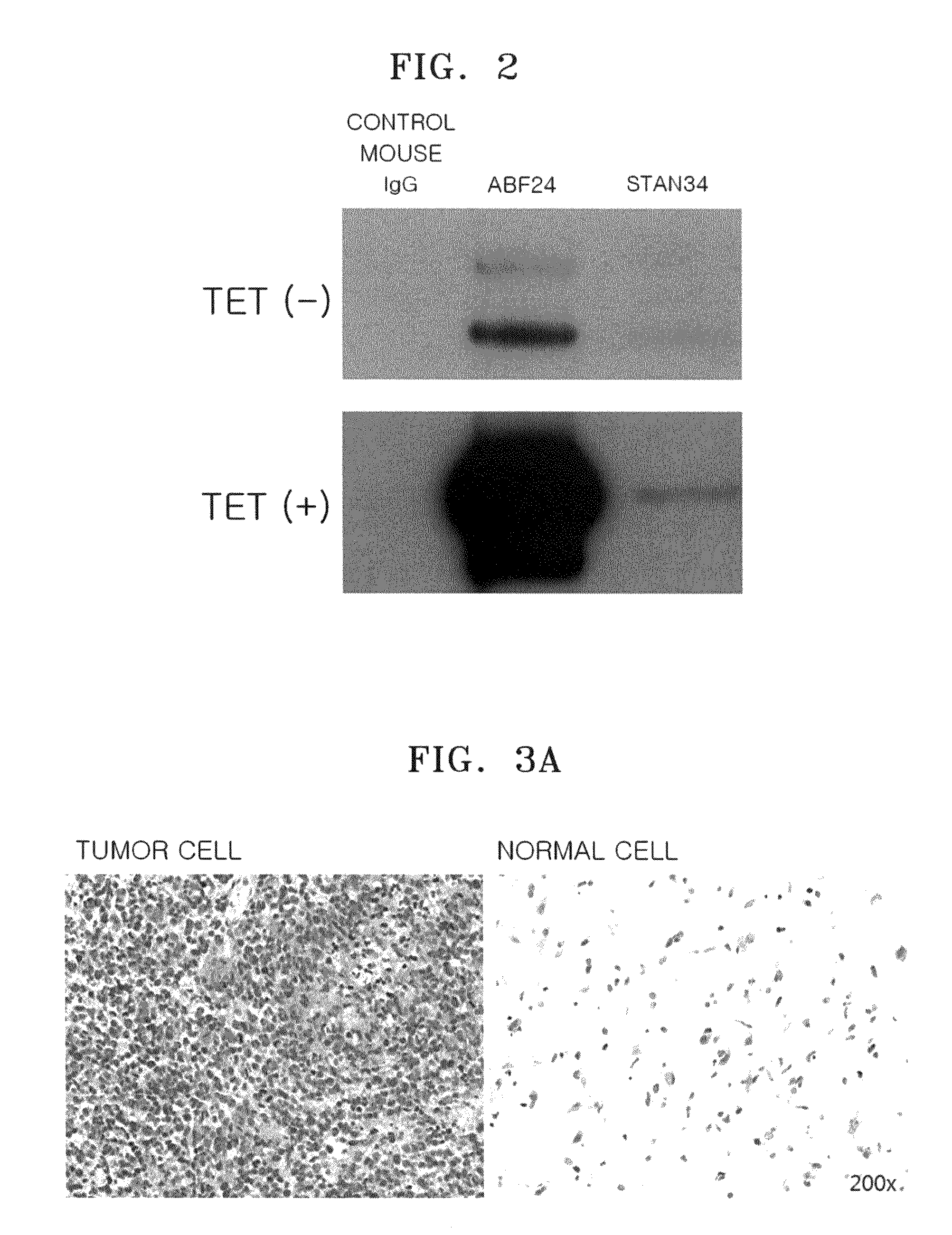Antibody specifically binding to c-Met and methods of use
a technology of antibodies and kits, applied in the field of antibodies specifically binding to c-met and kits, can solve the problems of anti-cancer drugs not working,
- Summary
- Abstract
- Description
- Claims
- Application Information
AI Technical Summary
Problems solved by technology
Method used
Image
Examples
example 1
Preparation of Hybridomas that Produce a Monoclonal Antibody Specifically Binding c-Met and Production of the Monoclonal Antibodies AbF24 and Stan34
[0126]The process of producing the hybridoma cell clones and obtaining monoclonal antibody, described below, is schematically illustrated in FIG. 1.
[0127](1) Immunization of Mice
[0128]Five 4 to 6-week-old BALB / c mice (Japan SLC, Inc.) were each given an intraperitoneal injection of 0.100 μg human c-Met / Fc fusion protein (R&D Systems, Inc.) emulsified in complete Freund's adjuvant. After two weeks, each mouse were again administered an intraperitoneal injection of 50 μg human c-Met / Fc fusion protein in incomplete Freund's adjuvant. After an additional week, a final boosting with the antigen in incomplete Freund's adjuvant was performed. Blood was collected from the tail of each mouse three days after the final boosting to obtain serum, which was diluted at 1 / 1000 with phosphate buffered saline (PBS) and subjected to an enzyme-linked immun...
example 2
Determination of Isotypes of Monoclonal Antibodies AbF24 and Stan34
[0139]An ELISA experiment was performed to determine the isotype of the two antibodies prepared in Example 1 using a BD Pharmingen™ Mouse Immunoglobulin Isotyping ELISA kit (BD Biosciences). The results of the assay are summarized in Table 2 below. From the results, the monoclonal antibody AbF24 is determined to have the highest reaction value, i.e., 2703.0, with the IgG1-specific antibody and the light chain was determined to be a k type. In addition, the monoclonal antibody Stan34 is determined to have the highest reaction value, i.e., 567.5, with the IgG1-specific antibody and the light chain was determined to be a k type (refer to Table 2).
TABLE 2mAbIgAIgEIgG1IgG2aIgG2b IgG3IgMdeterminationLight chainAbF2410.044.52703.03.010.04.05.02703.0IgG1κStan345.545.0567.54.07.01.01.0567.5IgG1κ
example 3
Determination of Recognition of c-MET from Different Species by Monoclonal Antibody AbF46
[0140]ELISA was used to determine whether the monoclonal antibodies AbF24 and Stan34 against human c-Met protein recognized mouse c-Met.
[0141]First, 50 μl (2 ug / ml) of human or mouse c-Met / Fc fusion protein (R&D Systems, Inc.) was added a well of a plate. Unreacted antigen was removed by washing. Then, 50 ng of purified monoclonal antibody AbF24 or Stan34 was added to each well and incubated with the antigen for 1 hour. Then, the well was washed with TBST to remove unreacted antibody. Goat anti-mouse IgG-HRP was added to the well, incubated at room temperature for 1 hour, and then was washed with TBST solution. Subsequently, OPD solution was added, and the degree of peroxidase reaction was evaluated by measuring absorption at 450 nm using an ELISA reader (Bio-Rad). It was determined that the monoclonal antibody AbF24 bound to the human c-Met and to the mouse c-Met protein.
[0142]Additionally, a c...
PUM
 Login to View More
Login to View More Abstract
Description
Claims
Application Information
 Login to View More
Login to View More - R&D
- Intellectual Property
- Life Sciences
- Materials
- Tech Scout
- Unparalleled Data Quality
- Higher Quality Content
- 60% Fewer Hallucinations
Browse by: Latest US Patents, China's latest patents, Technical Efficacy Thesaurus, Application Domain, Technology Topic, Popular Technical Reports.
© 2025 PatSnap. All rights reserved.Legal|Privacy policy|Modern Slavery Act Transparency Statement|Sitemap|About US| Contact US: help@patsnap.com



